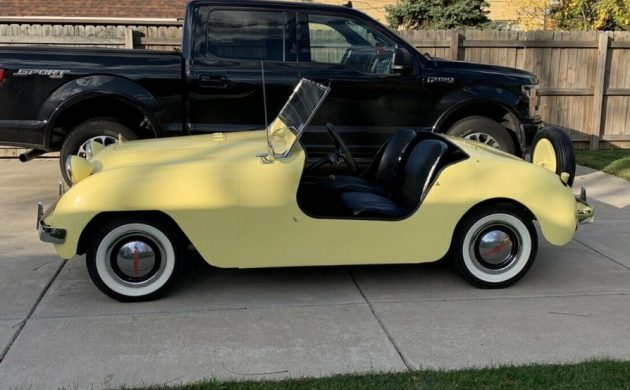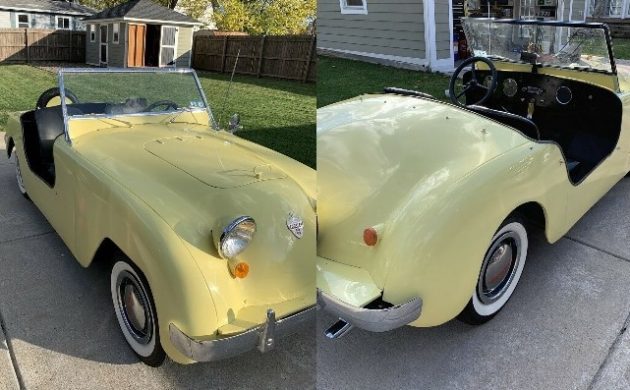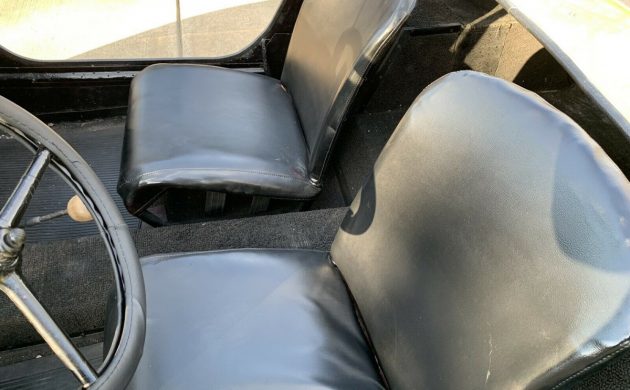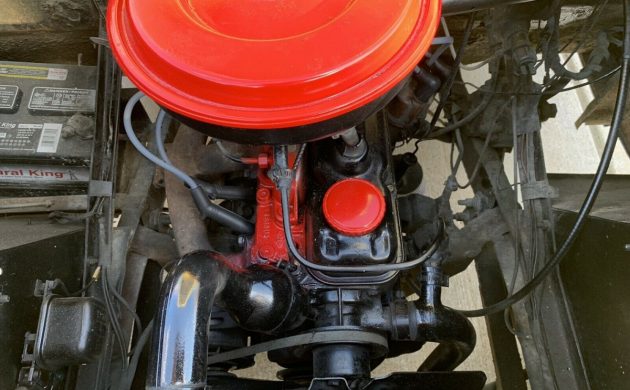If you were asked what the first post-war American sports car built was, you might say the Chevy Corvette. And if you did, you’d be wrong. It was the Crosley Hotshot, although much smaller and less powerful than either the ‘Vette or the Ford Thunderbird. The Hotshot would see only four years of production before the company ceased operations. This 1950 edition looks pretty darn good, although the seller mentions a few flaws. Available in Buffalo, New York and here on eBay, the bidding has reached $3.950 with the reserve still dangling.
By the time the Hotshot came out, Crosley Motors was an experienced builder of small cars dating back to the 1930s. As a small, independent car manufacturer, they were known for several firsts: slab-sided styling, sport utility vehicles, all-steel station wagon, and 4-wheel hydraulic disc brakes. All pioneered by Crosley. The Hotshot was unveiled in 1949 as a door-less 2-seat roadster that was probably more show than go. It had a low ground clearance and balanced chassis dynamics, which permitted quicker responses and easier maneuverability. Suspension was the key, and the Hotshot had semi-elliptic leaf springs in the front (six-on the left side, five on the right) while the rear wore both leaf and coil springs. Hydraulic shock absorbers were installed at all four corners. The little roadster had a 44 cubic inch 4-cylinder engine good for 26-27 horsepower. For a full report of the little Crosley, check out Hemmings.
Specific production records are said to be lost after Crosley ended in 1952, but estimates are that 2,500 Hotshots were built by Crosley in four years. The seller’s copy is from 1950 and – from the photos provided – looks better than the seller says it is. The body and paint are in very nice condition, although we’re told there are some imperfections. The seller describes it as “driver-quality paint.” The interior, top and side windows all look good, but we’re told it could use some carpeting. The tires are new except the spare, which is only for show.
The little motor is not original to the car, but it’s said to run well. The car has been given a tune-up and an oil change and the 3-speed manual transmission shifts as it should. The wiring is a bit amiss, so it will need some work in order for the lights and other things to function. So, it won’t be road-worthy until then. There is an unidentified noise coming from near the seats and the exhaust is going to need a weld.
Back in the day, a new Hotshot could be had for under $1,000, making it desirable to both sports car people and the general public. Hagerty says that a Concours Hotshot could go for north of $30,000, so if you only give this one a grade of “good,” it should fetch $12,000. At the current bidding, this little gem might end up being a cheap and interesting way to get into car collecting.







Classic swing and a miss. The LAST thing people wanted coming out of Dubja, Dubja 2, der, was some pip squeak of a car. Returning GI’s wanted fire and brimstone, not 4 cylinder roller skates. 50 years later, it may have had a chance. These were poor automobiles, one piece engine was a hassle, and the disc brakes, while novel, worked poorly, and I read, Crosley went back to drum for ’51. I think the 1st real American sports car, of any merit, was the Nash-Healey in 1951. These never had a chance and it’s an odd fact, Crosley was one of the biggest radio makers, but their cars never had them.
I tend to agree with you, The Nash Healey proved itself in competition many times, including a 4th place finish in the 1950 24 hrs of Lemans.
Crosley won their class at Sebring.
Sorry Howard, but the first postwar American sports cars was indeed the Crosley Hot Shot. Tom McCahill concurred. That Powell Crosley’s auto manufacturing endeavor wasn’t a success is without question. Soon there were imports that offered more in the sense that though small they were not caricatures of large American cars.
The Hot Shot was America’s sports car – winning the first 6 hour Sebring race per the applicable specs, but more impressive is “le biplace torpedo” at Le Mans in 1951:
http://classic-cars-talks.blogspot.com/2012/08/crosley-at-le-mans-1951.html
Click to enlarge photos.
The ’51 Nash Healey was comprised of a stretched British Healey Silverstone chassis with Nash mechanicals including torque tube rear and body by Panelcraft Sheet Metal in Birmingham. It was the second American sports car and are my preferred Nash Healeys other than the competition cars. The competition Healey’s bore little resemblance to the production cars.
Nash Healey Competition Cars – Article covering all the Le Mans cars from X5 to X15:
https://www.carsceneinternational.com/nash-healey-competition-cars/
By 1953 the streamlined cars were no longer competitive – the Nash “production engine that had never been particularly sophisticated to begin with” was not capable of keeping pace with the competitors engine performance.
The X5 video makes it clear this was first and foremost a racing sports car not a modified production car.
Returning GIs but lots of MG TDs and TR3s Because that’s the kind of thing they saw in Europe. There wasn’t much fire and brimstone in those. And I guess I don’t understand your reference “dubja “ I hope that wasn’t a disrespectful reference to the war.
dubya = W
No disrespect.
Crosley also made refrigerators. I had to look closely at this to be sure it wasn’t one being done by a friend.
My parents had a Crosley fridge, the color, green, natch.
The Crosley Shelvador refrigerator and the inventor who sold his invention for $15,000 (roughly $300,500 adjusted for inflation 2020 dollars). Fifteen grand in ’33 had far more purchasing power than 300k today. He could have had millions 25 cents at a time. I believe this version is correct rather than it being Powell Crosley’s idea.
From ’33 through the WWII and beyond with the Crosley Shelvador fridge thanks to Planet Retro:
https://blog.retroplanet.com/shelvador-fridge/
so did/does GM.
So did/does General Electric.
Gpa bought one when he got home from Korea, a Supersport version, even drove off with Gmail on their wedding day in it. When he came home from Vietnam, he stuffed a 340 Mopar and 727 auto in it with a narrowed Mopar 8.75 rear and went drag racing with it! There’s an old video of it on YouTube from the late 80s of one of its last runs. Best time was 10.98 in the 1/4 mile, and the car was deemed unsafe due to not enough rollcage, and gpa didn’t want to cut it up to go faster. He lost the bug for racing shortly after and parked it. The car is still in last race trim, and is still in the family, but the elements have been less than kind to it, and no revival plans are being made currently. Thanks for reading.
Hey, Robb with two “b’s” I’ve never heard a grandfather being referred to as GPA nor grandmother called GMA (or gmail as your predictive text spellchecked it). LOL Other than your shorthand for us old geezers to plod through….it would be very interesting to see that Hot Shot in it’s current state to see how the metal held up verses other cars made of carbon steel from the 1950s. I’m looking for the drag video too.
I’ll try and snap some photos of it and somehow post it. If you search Crosley vs Duster on YouTube you should be able to locate it easily.
I found the video here ;
https://youtu.be/uhY3FV37egk
The Duster in the video was built by my Grandfather and mother and sported a 440 they pirated from grandmas 1970 Chrysler 300 and built up reasonably. Grandma said it was ok as long as she couldn’t tell the difference when she got on the freeway, so the 300 got a mild 383 in exchange.. Mom was racing her 1968 Barracuda elsewhere the day the video was taken so my Uncle is driving it. Mom says he didn’t know how to handle the car properly…
Very cool trip down memory lane. That match up would have made my day in the 1980s….a Mopar powered Hot Shot and a Duster eating its dust! All in the family.
Did anyone notice that the engine is not a Crosley? It is an Opal engine and maybe an Opal gearbox. This seller is bad news. Saying is is not the original engine implies it is not a numbers matching car. He was trying to pull a fast one.
I am selling the one selling the car. I was not misleading to anyone. When you mentioned that to me while it was on eBay I realized that and tried to correct it but it would not let me change anything to close to the end of auction. I don’t appreciate you telling people I was trying to be pull a fast one.
What are the specifications on the engine, transmission and rear end?
So Craig is that an Opel engine? Source vehicle? Displacement?
I’ve heard of the Crosley Hotshot, but other than pics of the car, I’ve never seen one.
I have a friend who has one that he has been rebuilding and updating. It has a Toyota driveline, for one thing. In fact, it’s just about this color. I had to message him to be sure this wasn’t actually his car. I believe he has done several Crosleys over the years. I remember one of the “artsy” guys I went to college with had a Crosley station wagon.
Actually crosleys were quite competitive, finished well at Le Mans. The engine, at first welded steel, later replaced by cast iron, was a rugged overhead cam motor which had been developed for pumps. I’ll wait for one with the original engine.
“Actually crosleys were quite competitive, finished well at Le Mans”.
Geez Louise. No. There was one Crosley entry at Le Mans and sadly – DNF at 40 laps. This factory supported team was a small ad hoc effort that failed to realize (until they arrived in France) that the American headlights were little more value than a couple of flashlights. An exaggeration. Close enough. Read “Crosley at Le Mans 1951” story in link above @ Nov 28, 9:28 am. Worthwhile.
Crosley did well in US competition, but primarily the results of a plethora of H modified specials. George Schrafft even entered his Le Mans car in the 1952 Sebring 12 hour race finishing 14th and 3rd in class, S750 and a Hot Shot finished 16th and 4th in class. However 7th overall and 1st in class was the DB Panhard, Second in class was another DB Panhard 13th overall and 5 laps in front of the Le Mans Crosley.
The Le Mans Crosley was a little jewel of its own – recently sold by Hyman Ltd.
It would not have faired well at Le Mans in 1952 as the S750 class was won by the 612cc Monopole X84 Panhard with relatively aerodynamic bodywork:
https://www.racingsportscars.com/wm/photo/1952/WM_Le_Mans-1952-06-15-060.jpg?dir=photo/1952&img=Le_Mans-1952-06-15-060.jpg&txt=©%20Dominique%20Gasnerie&wi=&mode=Null
Auction ended at a max bid of $4,050, Reserve Not Met.
Having a hard time considering a vehicle that falls under the category of ‘Micro Cars’ a sports car.
Reminds me of the Kleinschnittger F125, just as cute. there is an english company which builts Kleinschnittger replicars using a Renault drive line. Anyway, this Crosley is I think lovely, but the engine? Fred V, talks about an ¨Opal¨ engine. what is that? Is he referring to OPEL?
Yes, sorry, fingers got moving too fast.
My brother had a Crosley station wagon in the early ’60s. It was cute and tough little car. No sports car by any imagination.
1947 Playboy built in Buffalo NY
The Crosley Car Owners Club:
http://www.facebook.com/CrosleyCarClub is free to join.
Really? REALLY! Twenty Six HP? There are 3 or 4 real cars that could lay claim to that title. I’ve been into cars my whole life and I’ve never heard the Crosleys mentioned as real cars, much less , sports cars. Only people who bought Crosleys were people with some cash who wouldn’t wait for a real car. Crosleys are cool, but at 26HP they were World’s Coolest Go -karts-Nothing more. Nice, but no cigar.
26.5 hp. That’s 6.5 more than a Model T, and something like 2/3 the weight. Doesn’t that sound just zippy to you?
I owned and drove a 50 “super sport” version of the Crosley Hot Shot.
Yes, they did make two versions, the Super sport had a folding top and doors.
I had no problem finding parts for the little car but I did sell it about ten years ago.
So isn’t it interesting that “Craig schreck” who claimed to be the seller never answered any questions about the drive train? But he’s not trying to be misleading, of course.
Wrong, Craig corrected himself and said it was powered by an Opel engine. Judging by the size alone, it appears to be the engine from a 1960´s -´70´s Opel Kadett. Why would he ¨claim¨ to be the seller, if he isn´t? and why the suspicious tone? The guy is probably just as ok as the rest on this forum. If there´s proof of perfidy, ok, but lacking that I think everyone should be giving everyone else a little slack here.
Seller could have answered more thoroughly, here. Where the curiosity is rampant. And maybe make a sale in the process. The listing was pulled from eBay so there is/was a chance he could turn someone into a buyer here. I think we are giving more slack now that we know it’s an Opel mill, but you Gerard answered for the actual seller. And you are the one giving your visual appraisal of what vehicle the motor came out of. Craig, some of us would love to know more about that powertrain and especially if it was in good nick when installed.
You are right on many counts. True, my comments were based on visuals, not on any in-depth knowledge. What however concerns me most if all, is maintaining a civil tone vis-a-vis others and not being accusatory. That´s all.
Fair enough. We could all use more civility these days on social media! I just went to eBay to pull up the original listing. Lots of photos and description of the engine but no identification. Also mention of a mechanical noise coming from under the seat which in my experience is usually an added fuel pump or fuel regulator. Hopefully one Barn Find reader will turn curiosity into a sale for ol’ Craig.
I have an MG Midget and a soft spot for small cars. I like the Crosley more than the King Midget although I am a fan of them as well. This isn’t a pristine car, so the smallest 4 cylinder with 5 speed ought to go in here and the clunky windscreen replaced with the Brooklands style mini shields. While we are at it dark olive green would be very fetching….